
The bullet journal weekly log is a powerful tool to organize your week. It connects your monthly goals with daily tasks, helping you manage time, track habits, and stay on top of deadlines. Here’s how to create one:
Start simple, experiment with designs, and find a system that works for you. A well-designed weekly log can boost productivity while keeping your planning process enjoyable.
Getting started with a weekly log begins with picking the right tools. Dot grid notebooks, like Leuchtturm1917 or Rhodia, are popular choices because they provide subtle guidance without being too restrictive [3].
You’ll need a few basic supplies: a fine-tip black pen, a metal ruler, and a pencil with an eraser for sketching. If you want to add some flair, consider stencils, washi tape, or colored markers for decoration.
Your layout should fit your planning style. Here are some common options:
| Layout Style | Best For |
|---|---|
| Vertical Columns | Organizing your week by time, with equal daily sections |
| Horizontal Rows | Task-heavy weeks that need extra list space |
| Dutch Door | Combining a weekly overview with extra details in fold-out sections |
To make your weekly log functional, include these key features:
Stick to consistent task symbols to keep everything neat [2]. For habit tracking, design a grid that lets you quickly check off completed habits daily [4].
Use a ruler to draw straight guidelines that divide your weekly spread into clear daily sections. Here’s how to set it up:
Once the structure is in place, you can add your personal touch.
Make your weekly spread work for you by adding personal flair and practical features. One easy way is to use color coding – assign specific colors to categories like tasks, events, deadlines, and notes (e.g., blue for tasks, green for events, red for deadlines, purple for notes).
To give your spread character, try these ideas:
"Although I need my journal to be practical, I also love to make it look good. Having a pretty bujo makes me smile every time I open a page to check something. It really boosts my mood." [2]
If you’re short on time but still want a stylish and functional layout, stickers can be a fantastic solution.

Themed sticker kits can help you effortlessly blend function and design. Dark Moon Paper offers several options to enhance weekly spreads:
These kits include practical elements like:
When using stickers, start with functional pieces like headers and task boxes. Once those are in place, you can add decorative elements to complete the look.
A bullet journal’s design makes it easy to incorporate tools like the Eisenhower Matrix into your weekly spreads. This matrix helps you sort tasks based on urgency and importance. Break tasks into four groups: ‘Do First’ (urgent and important), ‘Schedule’ (important but not urgent), ‘Delegate’ (urgent but less important), and ‘Eliminate’ (neither urgent nor important). For instance, handle pressing deadlines under ‘Do First’ and plan future-focused tasks under ‘Schedule’.
Combine this approach with time-blocking by assigning your most crucial tasks to the times when you’re most productive. Once tasks are prioritized, add them directly into your weekly and daily logs for smooth execution.
The weekly log serves as a link between your monthly goals and daily tasks. At the start of the week, revisit your monthly objectives and break them into smaller, actionable steps for your daily spreads.
You can include:
Set aside 15 minutes at the end of each week to:
Mark tasks moving to the next week with the "migration" symbol (>) [3].
"The weekly log provides a broader overview compared to the daily log, helping you maintain perspective while managing detailed daily activities and tasks" [1].
Running out of space in your weekly logs? Try a vertical layout to organize tasks more effectively. If you have extra tasks that don’t fit, create a separate "brain dump" page and link it back to your weekly spread using simple reference symbols.
Quick tip: Use symbols like ‘→’ for tasks you’ve moved or ‘⭐’ to highlight priorities. Adding these to the margins keeps your planning neat and saves space.
"Maintaining a bullet journal can feel overwhelming, especially when creating spreads takes too much time." [4]
Feeling stuck or unmotivated? Here are a few ways to stay on track:
"Individuals succeed in making the bullet journal habit long-term when they have a more realistic set of expectations, along with tools and techniques that nip any problems in the bud." [2]
Your weekly log should evolve with you. Take time to regularly evaluate what’s working and what’s not. Remove sections you don’t use and expand the ones that add value.
Ideas for adjusting your layout:
A bullet journal weekly log is a planning tool designed to fit your personal needs. Research from Dr. Gail Matthews shows you’re 42% more likely to hit your goals just by writing them down.
Key tips for success:
"Your Bullet Journal should work for you and reflect your journey." – Masha Plans, Bullet Journal Expert
Here’s how to get started and make the most of your weekly log:
By applying these practical strategies and staying consistent, your weekly log can become a go-to tool for staying productive and inspired. Whether you prefer a minimalist approach or a more decorative style, your bullet journal should fit your lifestyle and keep you on track.
"It’s very strange, but the mere act of writing anything is a help. It seems to speed one on one’s way." – Katherine Mansfield
A Bullet Journal weekly spread helps you stay organized and focused by combining essential components with personalized touches. Here’s a breakdown of the key elements:
| Core Component | Purpose |
|---|---|
| Weekly Calendar | Keep track of appointments, deadlines, and tasks. |
| Task Sections | List daily to-dos and activities for easy reference. |
| Notes Area | Jot down important info, reminders, or quick ideas. |
| Trackers | Monitor habits, moods, or recurring activities. |
| Next Week Overview | Plan ahead and ensure smooth transitions. |
While these core features provide structure, you can add sections that suit your lifestyle, like meal plans, goal-setting areas, or even creative doodles.
"A weekly spread is your way of keeping track of what needs to be done during the week." [2]
Pro Tip: Start simple. Experiment with layouts and adjust them as you discover what works best for you. The goal is to keep your spread functional and easy to use.
Stickers Made for Planning
Our custom stickers are a fuss-free way to brighten up your planner pages with perfectly-sized designs that add a spark of personality to every layout.
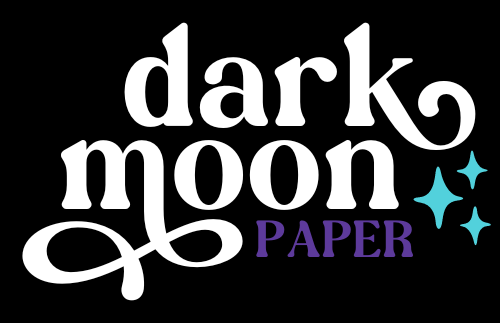
Why use planner stickers?
Planner stickers make organizing easy, fun, and personal! Add color, creativity, and structure to every page, transforming your planner into a tool that reflects you. Perfect for tracking, decorating, and staying inspired daily!
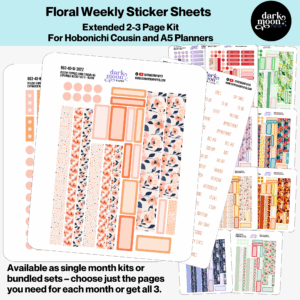
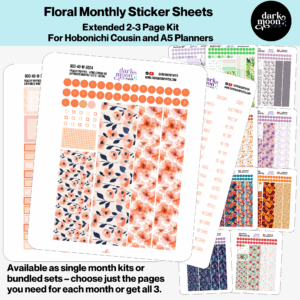
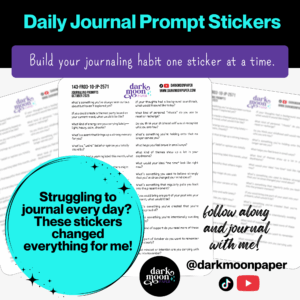
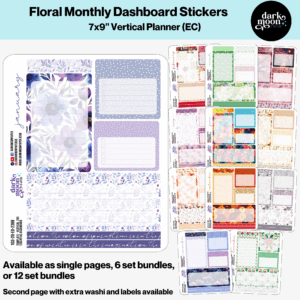
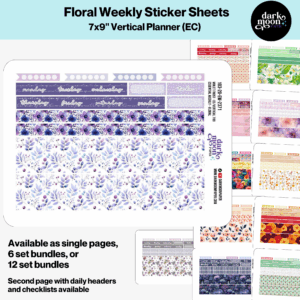
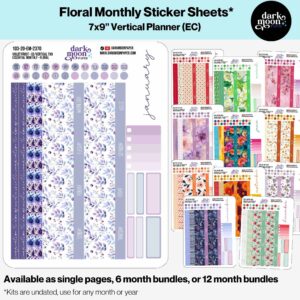
Hello and welcome!
I’m Kat, the artist behind Dark Moon Paper. I started this studio to blend my love of art, handwriting, and the small rituals that make everyday life feel magical. My sticker kits and creative resources are made to set the mood, spark ideas, and give you a little escape from the ordinary.
I create from a cozy studio in the Oregon woods, surrounded by nature and a clear view of the stars.
✨ Artistic inspiration for your planner. ✨